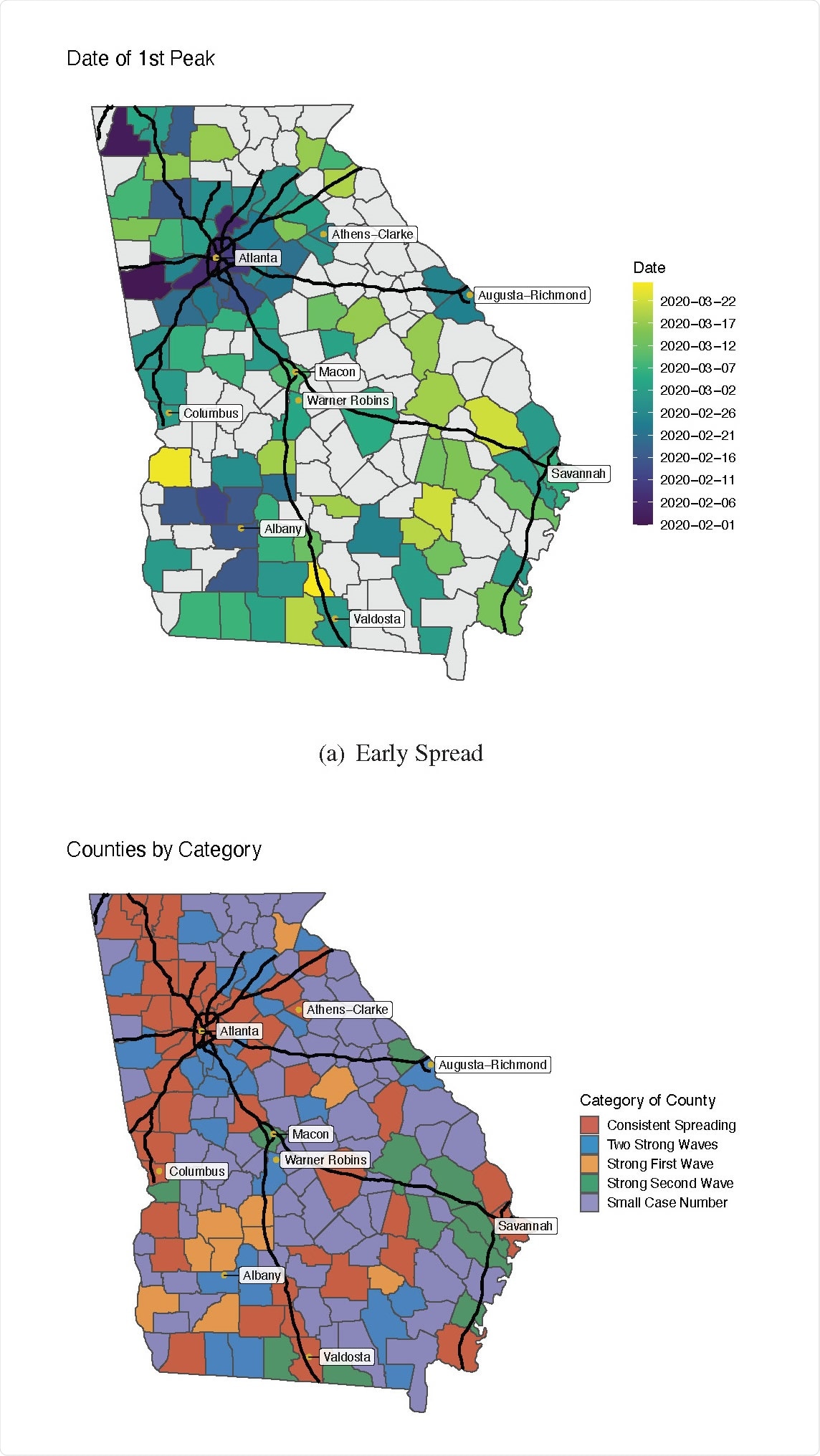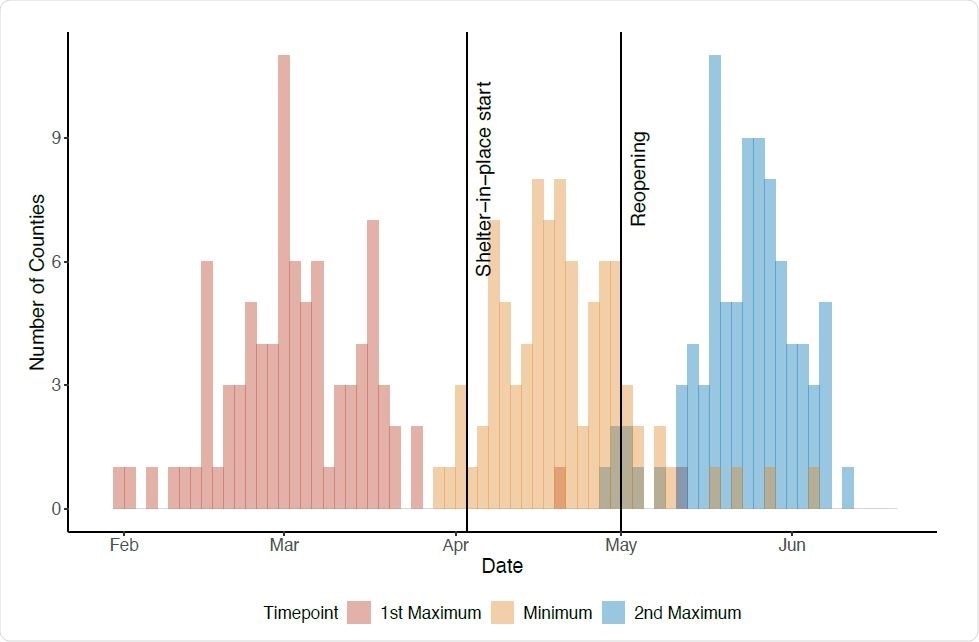Peter Teunis (Emory University) and colleagues found that between February and July, the serial interval (time between successive cases) for symptom onset shortened by approximately 1.5 days and that the major contribution to transmission shifted from an older age group (40 to 70 years) to a younger one (20 to 50 years).
The researchers also report that the shelter-in-place order (where people are told to stay indoors) was not enough to prevent transmission in urban areas connected by major transport links.
The team also advises that studying local transmission patterns may help guide states in preventing and controlling COVID-19, according to population and region.
A pre-print version of the paper is available on the server medRxiv*, while the article undergoes peer review.
The rapid surge in confirmed COVID-19 cases and deaths
Since the first cases of COVID-19 were identified in Wuhan, China, late last year, the causative agent severe acute respiratory syndrome coronavirus 2 (SARS-CoV-2) has rapidly spread across the world and has become an urgent global public health threat.
As of October 27th, 2020, the United States had the highest number of confirmed COVID-19 cases (8,773,407) and deaths (226,604) globally, and the state of Georgia had 353,372 confirmed cases and 7,844 deaths.
On March 14th, the number of confirmed cases in Georgia was 1,712, and the government declared a public health emergency. Large gatherings were prohibited on March 24th, and a shelter-in-place order was announced on April 3rd. On April 24th, Georgia was the first state to permit the reopening of some businesses, and by April 30th, the shelter-in-place order had been lifted.
On June 1st, the government relaxed the limits on the size of public gatherings, allowed bars and nightclubs to reopen, sports events to resume, and summer schools and camps to start sessions.

Spatial patterns of transmission of COVID-19. (a) date of reaching the peak (local maximum of Rt) for the first wave. (b) spatial distribution of the five categories of transmission patterns of COVID-19 in Georgia by June 15, 2020. The black lines represent the interstate highways.

 This news article was a review of a preliminary scientific report that had not undergone peer-review at the time of publication. Since its initial publication, the scientific report has now been peer reviewed and accepted for publication in a Scientific Journal. Links to the preliminary and peer-reviewed reports are available in the Sources section at the bottom of this article. View Sources
This news article was a review of a preliminary scientific report that had not undergone peer-review at the time of publication. Since its initial publication, the scientific report has now been peer reviewed and accepted for publication in a Scientific Journal. Links to the preliminary and peer-reviewed reports are available in the Sources section at the bottom of this article. View Sources
Number of new infections continued to surge in Georgia
As the number of new infections continued to surge in Georgia and other states throughout June and July, it became important to understand the impact the shelter-in-place order and reopening events had on the transmission of COVID-19 in different regions.
However, when Teunis searched PubMed for articles published on and before October 11th, 2020, they found that, while a few studies had estimated the serial interval, no study had examined the time-varying serial interval. Similarly, few studies had examined transmission patterns between groups with different characteristics, and no study had examined the time-varying reproduction number for COVID-19 or the impact of the shelter-in-place order at the county level anywhere in the United States.
What did the current study involve?
The team examined the characteristics of COVID-19 transmission in Georgia by estimating serial intervals and the reproduction number at a given time point (Rt) using epidemiological data based on reports of confirmed cases from the Georgia Department of Public Health.
Between February 1st and July 13th, the researchers identified a large number of linked cases (4,080 transmission pairs, [infectors and infectees]) and estimated the distribution of the serial interval for COVID-19 symptoms.
Using the serial interval distribution, the researchers could then estimate the Rt. By examining Rts over time, they could study the spatial distribution of transmission across all 159 Georgia counties and the impact of the shelter-in-place order and the gradual reopening events.

Distributions of estimated dates of first maximum, minimum, and second maximum in Rt for 87 counties with cumulative 200 cases by July 13, 2020, and key events possibly driving COVID-19 transmission.
Transmission varied by area and changed over time and by age group
The transmission of COVID-19 in Georgia had varied by area and changed over time between February and July.
The transmission was more significant in counties located around major cities and along major interstate highways. The serial interval fell from 5.97 days in February–April to 4.40 days in June–July.
Patterns of transmission over time also changed by age group. COVID-19 mainly spread from adults to all age groups, but the major contribution to transmission shifted from those aged 40 to 70 years in February–April to those aged 20 to 50 years in June–July.
“Younger adults (20–50 years old) were involved in the majority of transmissions occurring during or after reopening after the shelter-in-place period,” write the researchers.
The team also found that while the shelter-in-place order implemented for three to four weeks slowed transmission, it was insufficient to prevent transmission to urban and peri-urban counties connected by major transport links.
What are the study implications?
“The contracting serial intervals and increasing spread by younger generation show the COVID-19 transmission at county level changes over time,” say Teunis and colleagues.
“The spatiotemporal patterns of transmission in county-level further provide important evidence to guide effective COVID-19 prevention and control measures (e.g., shelter-in-place) in different areas,” advises the team.

 This news article was a review of a preliminary scientific report that had not undergone peer-review at the time of publication. Since its initial publication, the scientific report has now been peer reviewed and accepted for publication in a Scientific Journal. Links to the preliminary and peer-reviewed reports are available in the Sources section at the bottom of this article. View Sources
This news article was a review of a preliminary scientific report that had not undergone peer-review at the time of publication. Since its initial publication, the scientific report has now been peer reviewed and accepted for publication in a Scientific Journal. Links to the preliminary and peer-reviewed reports are available in the Sources section at the bottom of this article. View Sources
Journal references:
- Preliminary scientific report.
Teunis P, et al. Transmission of COVID-19 in the state of Georgia, United States: Spatiotemporal variation and impact of social distancing. medRxiv, 2020. doi: https://doi.org/10.1101/2020.10.22.20217661, https://www.medrxiv.org/content/10.1101/2020.10.22.20217661v1
- Peer reviewed and published scientific report.
Wang, Yuke, Casey Siesel, Yangping Chen, Ben Lopman, Laura Edison, Michael Thomas, Carly Adams, Max Lau, and Peter F.M. Teunis. 2021. “Severe Acute Respiratory Syndrome Coronavirus 2 Transmission in Georgia, USA, February 1–July 13, 2020.” Emerging Infectious Diseases 27 (10): 2578–87. https://doi.org/10.3201/eid2710.210061. https://wwwnc.cdc.gov/eid/article/27/10/21-0061_article.